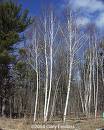White Birch Tree Information
Images of White Birch:






White Birch grows in the following 40 states and provinces:
Alaska, Alberta, British Columbia, Colorado, Connecticut, Hawaii, Idaho, Illinois, Indiana, Iowa, Maine, Manitoba, Massachusetts, Michigan, Minnesota, Montana, Nebraska, New Brunswick, New Hampshire, New Jersey, New York, North Carolina, North Dakota, Northwest Territories, Nova Scotia, Ohio, Ontario, Oregon, Pennsylvania, Prince Edward Island, Rhode Island, Saskatchewan, South Dakota, Vermont, Virginia, Washington, West Virginia, Wisconsin, Wyoming, YukonInformation about White Birch:
The Betula Papyrifera is commonly known as the Canoe Birch, Paper Birch, Silver Birch as well as White Birch.
The currently accepted scientific name of paper birch is Betula papyrifera Marsh. . It is wide ranging and exhibits considerable ecotypic variation. Six intergrading geographical varieties are recognized : var. papyrifera - typical paper birch var. cummutata (Regel) Fern. - western paper birch var. cordifolia (Regel) Fern. - mountain paper birch var. kenaica (W. H. Evans) Henry - Kenai birch var. neoalaskana (Sarg.) Raup - Alaska paper birch var. subcordata (Rydb.) Sarg. - northwestern paper birch Birch (Betula spp.) is a genetically plastic genus, often with morphological variation continuous between species . Hybridization is common. Paper birch naturally hybridizes with almost every native species in the genus. Named hybrids include : B. p. var. neoalaskana x B. glandulosa = B. X eastwoodiae Sarg. (Syn. = B. X dugleana Lepage) B. papyrifera x B. nana = B. X hornei Butler B. papyrifera x B. populifolia = B. X caerulea Blanchard B. papyrifera x B. occidentalis = B. X utahensis (Britt.) Dugle (Syn.= B. X piperi Britton) B. papyrifera x B. pumila var. glandulifera = B. X sandbergii Britt. Crosses with yellow birch (B. alleghaniensis), sweet birch (B. lenta), and river birch (B. nigra) have not been named. Paper birch has a transcontinental distribution across northern North America. It grows from Newfoundland and Labrador west along the northern limit of tree growth across Canada to northwestern Alaska, south to Washington, east and north in the mountains to western Montana and southwestern Alberta, east across the Prairie Provinces to Manitoba, and south and east through the Lake States to New England. Scattered outlying populations occur in the Great Plains of Montana and North Dakota, the Black Hills, the Appalachian Mountains from central New York to western North Carolina, and the Front Range of Colorado . Paper birch is cultivated in Hawaii . Detailed descriptions of the ranges of the six varieties are available .In boreal spruce ecosystems, paper birch forms nearly pure, pioneer communities on disturbed sites. It is rare in late successional or climax forests and generally restricted to openings. It is a principal component of boreal mixedwoods in Canada because its pioneering habit is favored by the relatively frequent 50- to 125-year fire return interval . Codominants in mixedwoods include trembling aspen (Populus tremuloides), black spruce (Picea mariana), white spruce (P. glauca), jack pine (Pinus banksiana), and balsam fir (Abies balsamifera). In the Northern Great Plains, paper birch forms climax woodland communities on moist, north- or east-facing slopes . Published classifications listing paper birch as a dominant in community types (cts), habitat types (hts), plant associations (pas), or ecosystem associations (eas) are presented below: Area Classification Authority interior AK postfire cts Foote 1983 AK general veg. cts Viereck & Dyrness 1980 AK: Kenai Peninsula forest veg. cts Reynolds 1990 MN: Boundary Waters general veg. cts Ohmann & Ream 1971 Canoe Area e MT, ne WY, w ND, forest & woodland hts Hansen & others 1984 w SD: Missouri Plateau sw ND woodland hts Girard & others 1989 c NF forest veg. cts Damman 1964 PQ: Gaspe Peninsula forest veg. cts Zolaseski 1988 St. Lawrence Valley general veg. pas Dansereau 1959 BC: Prince Rupert Forest general veg. eas Haeussler & others 1984 Region, Interior Cedar- Hemlock Zone w-c Alberta forest eas Corns & Annas 1986Some of the information provided here is attributed to:Uchytil, Ronald J. 1991. Betula papyrifera. In: Fire Effects Information System, [Online]. U.S. Department of Agriculture, Forest Service, Rocky Mountain Research Station, Fire Sciences Laboratory (Producer). , available at the USDA Fire Effects Information System (FEIS) website